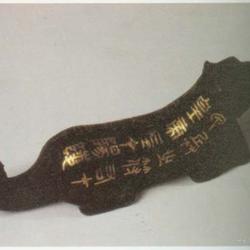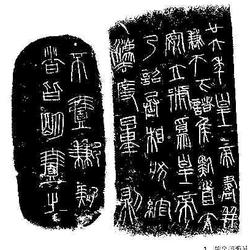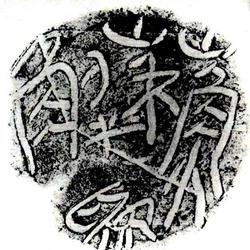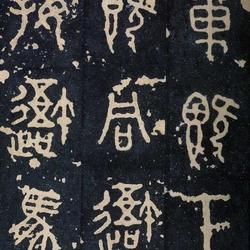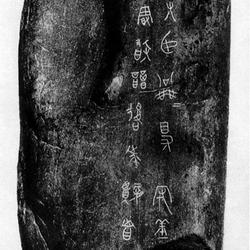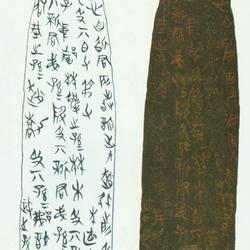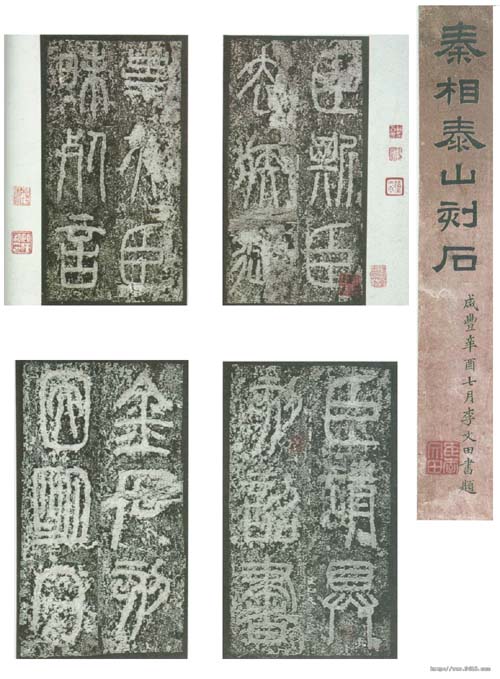
Explanation: I'm going to be sick, I'm going to be sick, I'm going to be sick, I'm going to die, I'm going to die.
Explanation: I'm going to be sick, the imperial censor, the minister is ignorant of death, I'm asking for an edict, gold and stone engraving, because I understand.
The stone carvings on Mount Tai of Qin Dynasty were erected in the 28th year of the First Emperor (219 BC) and are the earliest stone carvings on Mount Tai.
At this moment, Shi Yuan is divided into two parts: the first half was carved when Qin Shihuang visited Mount Tai in the East in 219 BC, with a total of 144 characters; the second half was carved in the first year of Qin II Hu Hai's accession to the throne (209 BC), with a total of 78 characters. . The four sides of the carved stone vary in width and width, and there are 22 lines of inscriptions, each line containing 12 characters, for a total of 222 characters. Both inscriptions were written by Li Si. There are only 10 remaining characters of the edict of the second Qin Dynasty, which is "I will go to the sick and ignorant dead ministers to invite you ministers", also known as "Taishan Cross". According to the "Taian County Chronicle" in the eighth year of Daoguang's reign in the Qing Dynasty (1828), in the fourth year of Zhenghe's reign in the Song Dynasty (1114), the stone was carved on the Jade Girl Pond on Daiding. There are 146 characters that can be read, and 76 characters have been destroyed and eroded. During the Jiajing period of the Ming Dynasty, Xu moved this stone to the east veranda of Yuanjun Palace in Bixia. At that time, only 4 lines and 29 words of the second-generation imperial edict remained, namely, "Chen Si, I will go to the sick, the censor, I will die, I will die, and I will engrave the edict on gold and stone." I understand that I am asking for death." In the fifth year of Qianlong's reign in the Qing Dynasty (1740), the Bixia Temple was destroyed by fire and the carved stone was lost.
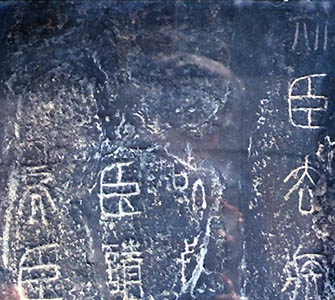
In the 20th year of Jiaqing (1815), Jiang Yinpei, an old Yin of Tai'an, led Chai Langao from the same city to search for 2 pieces of broken stones in the Jade Girl Pond on the top of the mountain, with 10 characters left, and then embedded the broken stele on the wall of Dongyue Temple on the top of Daiding. In the twelfth year of Daoguang's reign in the Qing Dynasty (1832), the Dongyue Temple wall collapsed. Xu Zongqian, the magistrate of Tai'an, "urgently retrieved the remaining stones from the rubble" and asked Taoist Liu Chuanye to move the remaining stones down the mountain, embed them in the wall of the Dai Temple stele, and write a postscript Remember what happened. In the 16th year of Guangxu (1890), the stone was stolen. The county magistrate Mao Dasuo took ten days to find the stone under the bridge at the north gate of the city, and then reset it in the Dai Temple courtyard. In the second year of Xuantong (1910), Yu Qinglan, the magistrate of the county, built a stone house in the Huanyong Pavilion of Dai Temple in order to prevent the carved stones from being eroded by wind and rain. In the stone house, three stones in total were embedded in the stone house: the Qin Taishan carved stones, Xu Zongqian's postscript and his own preface. Surrounded by iron fences for protection. In 1928, it was moved to the east throne of Dai Temple and built a portal-style stele niche with the above three stones built into it. After the founding of the People's Republic of China, glass was installed on the front of the stele niche for protection.
There are many imitation rubbings of the Qin Taishan carved stones in the past dynasties. There are two existing inscribed stones, the 29-character rubbings from the Ming Dynasty copied by Nie Jianguang of the Qing Dynasty and the 29-character rubbings from the old version copied by Xu Zongqian. Both are displayed in the stele gallery of Dai Temple. In 1987, the Tai'an Municipal Museum copied the full text of Qin stone carvings and erected it in the palace behind Dai Temple.
Qin Taishan carved stones have important artistic value and historical value. The calligraphy is rigorous and vigorous, steady and graceful; the characters are fair and well-proportioned, slender and graceful; the lines are round and strong like iron, becoming rounder and squarer; the structure is symmetrical, horizontally and vertically, clumsy on the outside and clever on the inside, with appropriate density. Yuanhe Jing praised: "The fist is like a hairpin, the butt is as straight as a tendon, and the curved iron grinds the jade, beautiful and strange. Thousands of years of thinness have made the strength fly, and looking back at the fat men, they are even more crazy." "History of Dai" said: "Although Qin has no way , His writings and calligraphy are unparalleled in the world." Lu Xun believed that the stone carvings in Qin Taishan were "quality and strong, and they are the source of the Han and Jin inscriptions." It is now a first-class cultural relic collection.
"Taishan Carving Stone" has 29-character rubbings, and 10-character rubbings are more common. The Song rubbings collected by Wuxi Anguo of the Ming Dynasty are the earliest, with a total of 165 characters. This rubbing was collected on July 1, the 15th year of Showa (1940). , purchased from Wan Cuixuan by Nakamura Fusaki (1866-1943). The other copy contains 53 characters and also went to Japan. It has been photocopied by Shanghai Yiyuan Zhenshangshe, Japan's "Shuyuan", Erxuanshe's "Calligraphy and Famous Products Series", etc. Among the Qin carved stones, this one is the only one with "Langyatai Carved Stones" It is true, the rest are copied by later generations.
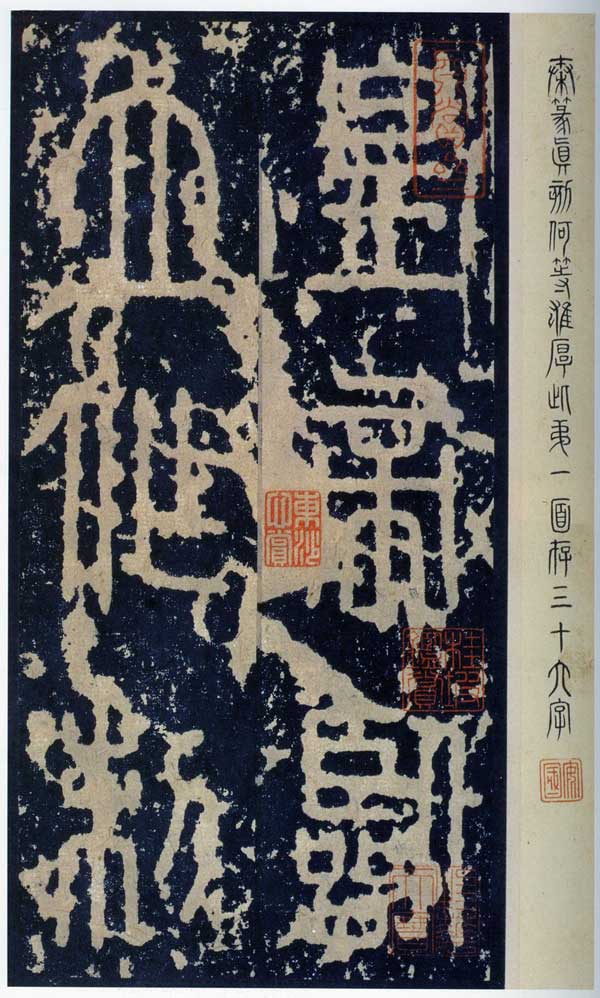
Taishan stone carvings (rubbings from Anguo and the Northern Song Dynasty) each have a length of 27.8 cm and a width of 14.3 cm.
Collection of the Taito District Calligraphy Museum, Tokyo, Japan (from the "Sino-Japanese Calligraphy Treasures Exhibition" of the Shanghai Museum in 2006)

